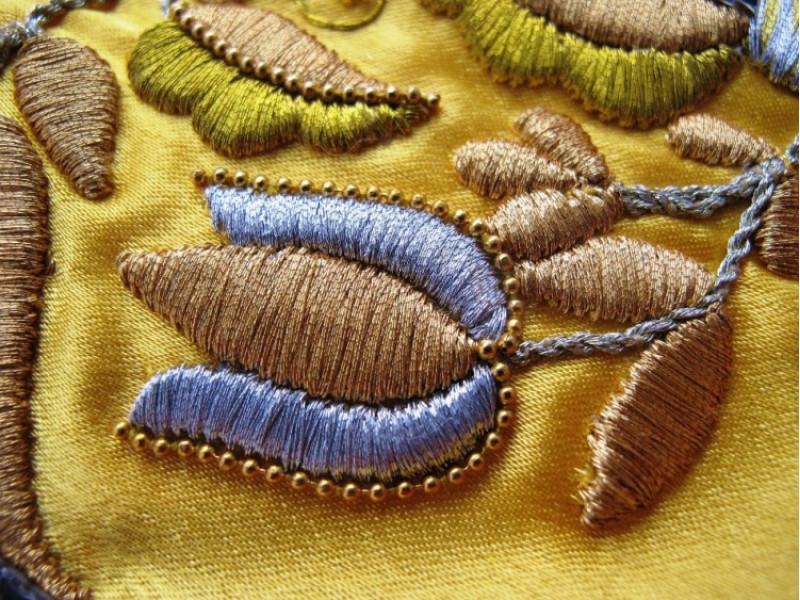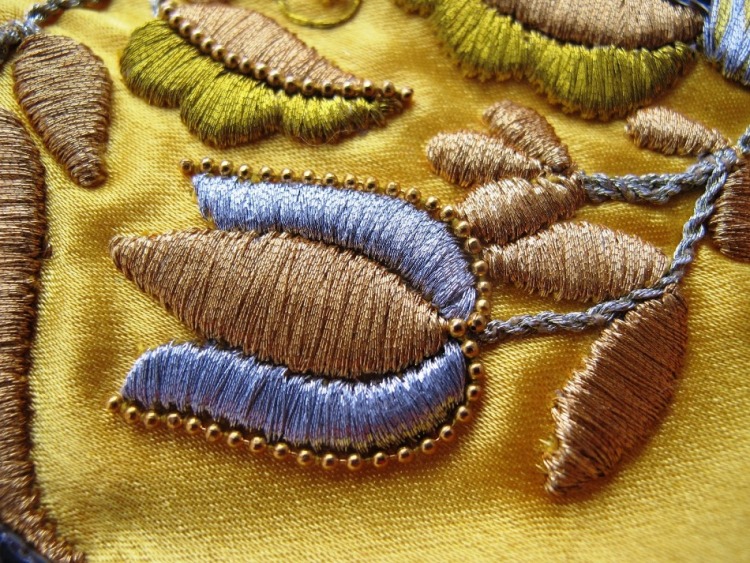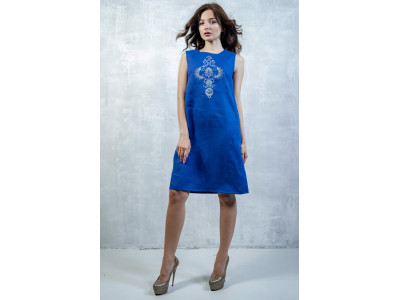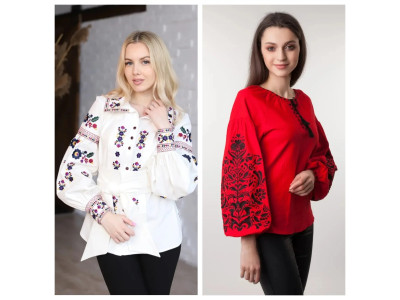Thorny path
Crimean Tatar embroidery, like, in fact, the entire Crimean Tatar people, has gone through a difficult path, with its ups and downs, with complete disappearances and sudden, somewhat fantastic revivals.
"Crimean Tatar embroidery is a unique phenomenon of world culture. Its themes and symbolism are connected with the ancient history of Crimea, with all the civilizations that passed through this land: Scythian, ancient, Byzantine, Turkic - all of them left a mark on the history of the indigenous people of Crimea - the Crimean Tatars. And this mark is traced, first of all, in embroidery," notes Honored Artist of Ukraine Mamut Churlu.
Associated with the traditions of Byzantium and the Middle East, Crimean Tatar embroidery was considered one of the best in terms of technique during the 15th-18th centuries.
Entire workshops of weavers and embroiderers operated at the Khan's court. The state authorities willingly sponsored and supported this industry, and many goods were exported to the Mediterranean, Asia Minor, and Russia.
Numerous wars with Russia and the subsequent annexation of the peninsula by the latter in the 18th and 19th centuries caused not only mass emigration of the population, industrialization of everyday life, and the decline of the economy, but also had a negative impact on the region's artistic crafts.
Weaving and embroidery needed reform, but for a very long time, until the 1930s, no one took up them. In 1925, the famous poet, publicist, and simply an expert on Crimea, Maximilian Voloshyn, wrote: “Tatar art: architecture, carpets, majolica, metal stamping – all this is over, only fabrics and embroidery remain. Tatar women, by innate instinct, still continue to squeeze precious plant patterns out of themselves. But even this skill is running out…”.
To prevent this skill from being completely exhausted, the authorities began to act. From a purely home craft, embroidery was transformed into a branch of industrial cooperation. About 350 embroiderers in the villages and cities of Crimea were united in an artel that was to export products. The first such artel was the Bakhchisarai "Ilk Adym" ("First Step"). In Yevpatoria, under the leadership of the famous researcher of Crimean Tatar embroidery P. Chepurina (we will mention her later), the artel "Eski Ornek" ("Ancient Pattern") was organized. Ornaments began to be used in other branches of applied art, for example, in 1936 a folklore collection of Crimean Tatar fairy tales was published, abundantly illustrated with folk ornaments. After the war and the deportation of 1944, the production of embroidered items faded away, but now, as another wave of latent popular sentiments rises, things are slowly getting better.
200 meters to the wedding
From a young age, a Crimean Tatar girl would sit at a loom. By the time of her wedding, she would have had time to weave and embroider up to 200 m of fabrics that were part of her dowry. This included towels, which, in addition to their usual purpose, were also hung on the walls of the bride's room, a shawl in which the dowry was wrapped, and the Quran, which was placed in a previously embroidered bag.
The young man gave the girl a clean handkerchief, and she showed her own attitude with her embroidery on it: a small flower meant goodbye, lush and rich embroidery meant a wedding.
Crimean Tatar women have much more embroidery in their wardrobe than men. Dresses, bibs, aprons, hats, and shoes on one side, and wedding belts, fezzes, and garters for socks on the other.
The basis for the production was fabrics: homemade white or cream linen cloth or semi-paper canvas. Wealthier people could afford silk, satin, velvet. The threads were mostly cotton, from the mid-19th century they, like factory wool (garus), began to be imported from abroad.
10 most popular techniques in Crimean Tatar embroidery
Now let's talk about the ten most popular embroidery techniques of the Crimean Tatars, which were highlighted in the 1930s by the aforementioned P. Ya. Chepurina.
"Tatar ishlema" (ishleme - work). Double-sided smooth sewing, which became very popular among the Crimean Tatars and included up to sixty different types of stitches, was performed with twisted silk, cotton, gold and silver threads on thin fabric without prior basting. The "Tatar ishlema" technique consists in the fact that the needle passes through the fabric by counting the holes in the base fabric. Having passed the needle inside out, you catch it from below with your left hand and make a turning movement into the wrong hole with the eye up, without changing the position of the needle in space. Such sewing "on the hole" gained popularity in the second half of the 19th century, displacing colored embroidery from the trendy shelf. It is preserved to this day, counting up to 47 group stitches. Marama (women's head coverings), sherbents (girls' headscarves), uchkur (men's wedding belts), beshik (covers for baby cradles), various scarves, napkins, tablecloths, as well as covers for the Quran were embroidered with double-sided smoothness.
"Esap ishleme" . The second most common embroidery technique, especially popular on the southern coast of Crimea, has seven stitches. "Esap ishleme" (or "Osmanli ishleme") is a counted transparent double-sided sewing, which, like "Tatar ishleme", was used to fill large spaces. By the way, the technique also had its supporters in Ukraine, where it was used mainly in white embroideries. From the end of the 19th - beginning of the 20th century, embroidery began to be performed on factory marquise, and before that, the basis was homespun "atma" or Turkish "dyulbent".
"Telly" . Sewing on the hole with a small gilded or silvered (from the end of the 19th century, cheaper materials began to be used, which significantly affected the quality of the embroidery) plate, 3-4 mm wide. Like the two techniques we considered above, "telli" is included in the group of double-sided embroidery, in which it is impossible to determine which side is the front and which is the back. Occasionally, you can see continuous embroidery made with this technique, and most often it is a combination with the counted "esap ishlema", less often - with the smooth "tatar ishlema". "Telli" was used on various types of towels and head covers.
"K'asnak" . A one-sided tambour (from the French "tambour" - drum) seam that occupies a significant place in the history of Crimean Tatar sewing, but at the same time is practically not found today. Made with a needle with a broken ring or a hook on a round hoop, "k'asnak" was in demand mainly among the Turkic-Mongol peoples. Thus, the Kazan Tatars have preserved samples of ornamentation typical of the Turkic peoples, marked by the influence of nearby areas. "K'asnak" with the technique of pouring tone-on-tone (this technique was used by the Karaites of Crimea during the Khanate period, but it did not become widespread among the Crimean Tatars themselves) made satin carpets in Damascus, Baghdad, etc. The advent of tambour machines in the 1870s caused a rather rapid decline of this technique, but in no way diminished its mark on history.
"Mykhlama" . Gold or silver one-sided embroidery, which was usually performed on velvet, satin or leather and was used in clothing details where the underside had no practical significance (women's hats, sleeve cuffs, jackets, Koran cases, caskets). In the Crimean Khanate, "mykhlama" was used to decorate horse saddlecloths, camping tents of the khans, some items of clothing of the latter, large wall pillows, etc. As you understand, the manufacture of such items required considerable strength and endurance, so this work was assigned to men, who were united in special workshops. Following the decline of the khanate, the workshops also disintegrated. "Mykhlama" migrated to home conditions, where it was already performed by women on special hoops "jilde" in the form of a vice with a screw.
"Bukme" . Imported to Crimea from the Anatolian coast of the Black Sea (Turkey), this embroidery decorated jackets, collars, cuffs, shoes, tobacco pouches, various cases and amulets. "Bukme" was made by placing gilded or silvered laces on the fabric, which were fastened with thread from below. As with "mahlami", the place of production of this embroidery was the "jilde" machine.
Additional types of embroidery. We have not yet considered four additional types of Crimean Tatar embroidery, which, although inferior in distribution to the previous six, still have significant practical significance and are valued by the people.
One of these types is applique embroidery, which gained popularity among the Tatars of the southern coast, as well as the Armenians of Transcaucasia and Turkey. Carpets, pillow covers and sofas - all this was done using the applique technique on dresses, felt and various fabrics. Separately, it should be said about carpets, the ornament of which was made by combining two techniques - applique and "k'asnak'u". Some samples of such carpets of the "parokhets" of the 18th-19th centuries are still kept in the Bakhchisarai Palace.
Embroidery with gold and silver beads, "pul", served mostly as a complement to "mahlami" and "bukme". This technique was a great alternative to precious stones for the poor. Embroidered beads added shine to suits, women's hats, brides' veils, men's purses, watch cases and Korans.
Coin embroidery served the same purpose as "pool". Social status undoubtedly played an important role: some decorated expensive costumes with gold coins, while others, due to the lack of these very coins, limited themselves to embroidering their images.
As in Bukovina , Crimean Tatars sometimes embroidered with beads imported from Iran and Asia Minor.
However, while Bukovinian embroiderers decorated the most solemn items of clothing and everyday life with it, Crimean Tatar embroiderers used it for "second-order" items: amulets, purses, cigarette cases, covers, etc. Not very wealthy Tatars replaced pearls with beads.
Ornaments and symbols in Crimean Tatar embroidery
The color scheme consists primarily of delicate colors: pinkish-greenish, bluish-yellowish. In Crimean Tatar embroidery, there is a visual effect of the mobility of the ornament, which is achieved due to the alternation of a limited number of colors when repeating compositions. If the effect of chiaroscuro in European embroidery was obtained due to the method of pouring color into color, then the Crimean Tatars achieved it due to the extraordinary variety of textured stitches.
In general, all ornaments can be divided into six groups: floral, geometric, architectural, zoomorphic, epigraphic and mixed. Some also separately distinguish astral bodies and vessels (vases with flowers and fruits). And although the symbolism of the ornaments is surprisingly diverse, Crimean Tatar embroidery still has a pronounced floral orientation. Zoomorphic and architectural motifs often appear in symbiosis with flowers, trees, fruits, characteristic exclusively for the nature of the Crimean peninsula.
Of course, images-symbols carry enormous spiritual power. Thus, at the base of the drawing there is often a triangle – a talisman, which can be depicted in the form of three leaves or a triangular vase. The traditional image of the “tree of life” is also popular, the strong branching of the branches serves as a wish for a large offspring for the Crimean Tatar family. The image of a rooster signifies the victory of good over evil, and the almond-shaped pattern of almonds was used by women ready for married life.
In some places, the ornaments contained inscriptions that, in addition to wishes for health and well-being, carried a purely incriminating meaning. O. Spaska, a well-known researcher of Crimean Tatar embroidery, gives translations of inscriptions on towels: "An ignorant, stupid, cunning person likes only appearance and form", "We, women, the centers of everything noble and precious, are nothing to him", "Try to please such an ignorant person, give him everything sacred when he has no taste in it". Agree, such inscriptions quite vividly reflect the social model of the Crimean Tatars and the position of women in society.
Today, the cities and villages of Crimea continue to embroider Quran covers (quran-kap), details of traditional costumes, macrame, headdresses (fez), modern mobile phone cases, decorative panels for home interiors (ev-jiyar). Crimean Tatar embroidery continues to follow a difficult path, new and new obstacles are put in the way of the art, but it has the strength to rise again and again.
Author: Maksym Timchenko.














Write a comment